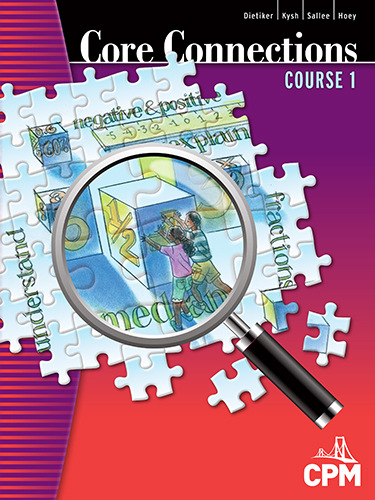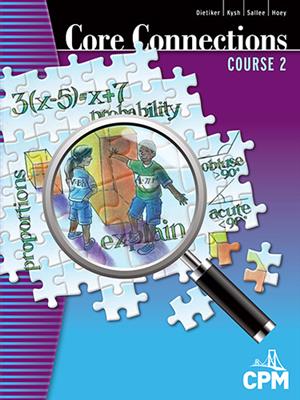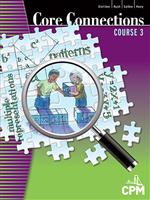- Christina School District
- Mathematics
- Middle School Math (6-8)
Academics & Curriculum
Page Navigation
College Preparatory Mathematics (6-8)
-
The Christina School District has adopted the College Preparatory Mathematics, known as CPM for grades 6-8.CPM provides problem-based instructional materials and professional development for teachers. CPM was originally an Eisenhower-funded grant program. CPM teaching strategies focus on how students best learn and retain mathematics. Teaching strategies rely on the recommendations of the National Council of Teachers of Mathematics, and are based solidly on the methodological research in teaching mathematics.The research-based principles that guide the course are:
- Students should engage in problem-based lessons structured around a core idea.
- Guided by a knowledgeable teacher, students should interact in groups to foster mathematical discourse.
- Practice with concepts and procedures should be spaced over time; that is, mastery comes over time.
-
While students are solving complex mathematical problems, they are communicating their thinking and understanding, both formally and informally, whether they are writing or speaking out loud. Communication helps to clarify students’ thinking, prepares them for sharing their ideas in professional settings, and formal or informal feedback that allows for revision. Communication lets teachers and peers assess students’ thinking and depth of understanding. In turn, all students get the chance to improve the quality of their work.The design of the book recognizes that not all students learn at the same pace. Research-based “spaced practice” addresses this reality by giving students the opportunity, in both classwork and homework, to practice, revisit, and eventually master and then extend ideas that may have been difficult at first. The classroom structure allows considerable opportunities for teachers to work individually with students who need assistance.The spaced practice structure of the homework assures that students practice ideas and skills over time to consolidate their knowledge for long-term retention. Each homework set contains work with the topics just introduced, as well as problems to practice, extend, and apply previously learned skills and concepts.Online homework help—solved problems, hints to get started, and references to previously solved problems—are available for no charge to provide additional support for students and parents.
Grade 6
-
 Core Connections, Course 1 is the first of a three-year sequence of courses designed to prepare students for a rigorous college preparatory algebra course. On a daily basis, students in Core Connections, Course 1 use problem-solving strategies, questioning, investigating, analyzing critically, gathering and constructing evidence, and communicating rigorous arguments justifying their thinking. Students learn in collaboration with others while sharing information, expertise, and ideas. The course helps students to develop multiple strategies to solve problems and to recognize the connections between concepts. The lessons in the course meet all of the content standards and embed the “Mathematical Practices” of the Common Core State Standards released in June 2010.
Core Connections, Course 1 is the first of a three-year sequence of courses designed to prepare students for a rigorous college preparatory algebra course. On a daily basis, students in Core Connections, Course 1 use problem-solving strategies, questioning, investigating, analyzing critically, gathering and constructing evidence, and communicating rigorous arguments justifying their thinking. Students learn in collaboration with others while sharing information, expertise, and ideas. The course helps students to develop multiple strategies to solve problems and to recognize the connections between concepts. The lessons in the course meet all of the content standards and embed the “Mathematical Practices” of the Common Core State Standards released in June 2010.Upon completion of this course, students should be able to:
- Collect, organize, and display data in multiple ways.
- Analyze data using measures of central tendency.
- Represent data sets using various methods and analyze how changes in data impact the representation.
- Represent and compare quantities using manipulatives, diagrams, and number expressions.
- Represent multiplication using rectangular arrays.
- Represent integers on number lines and with manipulatives.
- Make sense of multiple representations of portions (decimal, fraction, percent) and convert from one form to the other.
- Compare fractions and generate equivalent fractions.
- Recognize ratios in tables and graphs and solve corresponding problems.
- Use ratios to describe relationships with similar plane figures and other situations.
- Use models and standard algorithms for computations with fractions and decimals.
- Simplify variable expressions by combining like terms and using the Distributive Property.
- Evaluate variable expressions and solve simple equations and inequalities.
- Solve distance, rate, and time problems.
- Solve percent problems including those with discounts, interest, and tips.
- Represent solids using nets.
Grade 7
-
 Core Connections, Course 2 is the second of a three-year sequence of courses designed to prepare students for a rigorous college preparatory algebra course. On a daily basis, students in Core Connections, Course 2 use problem-solving strategies, questioning, investigating, analyzing critically, gathering and constructing evidence, and communicating rigorous arguments justifying their thinking. Students learn in collaboration with others while sharing information, expertise, and ideas. The course helps students to develop multiple strategies to solve problems and to recognize the connections between concepts. The lessons in the course meet all of the content standards and embed the “Mathematical Practices” of the Common Core State Standards released in June 2010.Upon completion of this course, students should be able to:
Core Connections, Course 2 is the second of a three-year sequence of courses designed to prepare students for a rigorous college preparatory algebra course. On a daily basis, students in Core Connections, Course 2 use problem-solving strategies, questioning, investigating, analyzing critically, gathering and constructing evidence, and communicating rigorous arguments justifying their thinking. Students learn in collaboration with others while sharing information, expertise, and ideas. The course helps students to develop multiple strategies to solve problems and to recognize the connections between concepts. The lessons in the course meet all of the content standards and embed the “Mathematical Practices” of the Common Core State Standards released in June 2010.Upon completion of this course, students should be able to:- Use integers and complete operations with integers and rational numbers, including using the Order of Operations.
- Use diagrams and equal ratios to represent part-whole relationships.
- Use percents and scale factors to determine percent increase or decrease, discounts, and markups.
- Use variable expressions to represent quantities in contextual problems.
- Simplify variable expressions by combining like terms and using the Distributive Property.
- Solve linear equations, including those with fractional coefficients and those with no solutions or infinitely many solutions.
- Solve and graph one-variable inequalities.
- Compare experimental and theoretical probabilities.
- Distinguish between dependent and independent events and calculate the probability of compound independent events.
- Represent probabilities of multiple events using systemic lists, area models, or tree diagrams.
- Design, conduct, and analyze surveys.
- Collect and compare data and describe the distribution of sets of data.
- Solve distance, rate, and time problems.
- Compare ratios and calculate unit rates.
- Recognize and solve problems involving proportional relationships.
- Recognize and use the properties of similar figures and scale factors to solve problems.
- Describe angles, angle pairs, and their measures.
- Compute area and perimeter of standard and compound shapes.
- Compute the volume of a variety of solids.
Grade 8
-
 Core Connections, Course 3 is the third of a three-year sequence of courses designed to prepare students for a rigorous college preparatory algebra course. On a daily basis, students in Core Connections, Course 3 use problem-solving strategies, questioning, investigating, analyzing critically, gathering and constructing evidence, and communicating rigorous arguments justifying their thinking. Students learn in collaboration with others while sharing information, expertise, and ideas. The course helps students to develop multiple strategies to solve problems and to recognize the connections between concepts. The lessons in the course meet all of the content standards and embed the “Mathematical Practices” of the Common Core State Standards released in June 2010.Upon completion of this course, students should be able to:
Core Connections, Course 3 is the third of a three-year sequence of courses designed to prepare students for a rigorous college preparatory algebra course. On a daily basis, students in Core Connections, Course 3 use problem-solving strategies, questioning, investigating, analyzing critically, gathering and constructing evidence, and communicating rigorous arguments justifying their thinking. Students learn in collaboration with others while sharing information, expertise, and ideas. The course helps students to develop multiple strategies to solve problems and to recognize the connections between concepts. The lessons in the course meet all of the content standards and embed the “Mathematical Practices” of the Common Core State Standards released in June 2010.Upon completion of this course, students should be able to:- Represent a linear function with a graph, table, rule, and context and create any representation when provided one of the others.
- Solve systems of equations by using tables and graphs.
- Symbolically manipulate expressions to solve problems including those with fractional coefficients.
- Solve contextual word problems using multiple strategies, including making tables, looking for patterns, drawing diagrams, and creating a table of guesses to assist with writing and solving a variable equation.
- Describe various geometric transformations on a coordinate grid.
- Represent data using scatterplots and describe associations.
- Collect and analyze data and make predictions based on the trend of the data.
- Compare ratios and calculate unit rates and slope ratios.
- Analyze the slope of a line graphically, numerically, and contextually.
- Recognize and solve problems involving proportional relationships.
- Graph and analyze non-linear functions.
- Recognize and use the properties of similar figures to solve problems.
- Use the Pythagorean Theorem and its converse to solve problems in two and three dimensions.
- Use square roots and cube roots.
- Represent and simplify expressions using positive and negative exponents.
- Represent and compare large and small numbers using standard and scientific notation.
- Perform operations with numbers represented in scientific notation.
- Use the relationships between angles created by parallel lines with transversals and the Triangle Angle Sum Theorem to solve problems.
- Compute the volume of a variety of solid.
Homework Help
-
The Homework Help website provides a variety of complete solutions, hints, and answers. Some problems refer back to other similar problems. The website is designed to assist students to be able to do the problems but not necessarily do the problems for them.
Core Connections, Course 1 – 6th Grade
Core Connections, Course 2 – 7th Grade
Core Connections, Course 3 – 8th Grade
Parent Support
-
To be successful in mathematics, students need to develop the ability to reason mathematically. To do so, students need to think about what they already know and then connect this knowledge to the new ideas they are learning. Many students are not used to the idea that what they learned yesterday or last week will be connected to today’s lesson. Too often students do not have to do much thinking in school because they are usually just told what to do. When students understand that connecting prior learning to new ideas is a normal part of their education, they will be more successful in this mathematics course (and any other course, for that matter). The student’s responsibilities for learning mathematics include the following:
- Actively contributing in whole class and study team work and discussion.
- Completing (or at least attempting) all assigned problems and turning in assignments in a timely manner.
- Checking and correcting problems on assignments (usually with their study partner or study team) based on answers and solutions provided in class and online.
- Asking for help when needed from his or her study partner, study team, and/or teacher.
- Attempting to provide help when asked by other students.
- Taking notes and using his/her Toolkit when recommended by the teacher or the text.
- Keeping a well-organized notebook.
- Not distracting other students from the opportunity to learn.
Assisting your child to understand and accept these responsibilities will help him or her to be successful in this course, develop mathematical reasoning, and form habits that will help her/him become a life-long learner.Need Additional Help?
Additional support for students and parents is provided at the CPM Homework Help site and in the Parent Guide.- The Homework Help website provides a variety of complete solutions, hints, and answers. Some problems refer back to other similar problems. The website is designed to assist students to be able to do the problems but not necessarily do the problems for them.
- The Parent Guide provides an alternative explanation of key ideas along with additional practice problems. The Parent Guide resources are arranged by chapter and strand.

